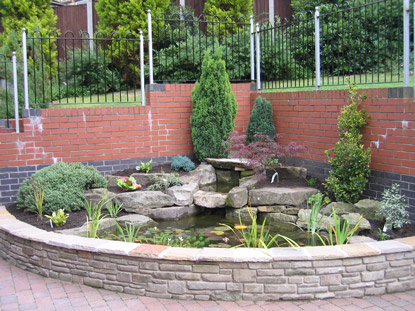Frog Blog – We have Frogspawn in the Office Pond!
Frog Blog – We have Frogspawn in the Office Pond!
Four years ago whilst some of us were away in Canada working on some palaeontology projects, arrangements were made to build a small pond behind the office. We had managed to persuade one of the designers of the animal enclosures from Chester Zoo to undertake the work and to produce a water feature with a seating area so that we could take our breaks and watch any wildlife that might be attracted to the water.
The work took about a week and our designer friend built two small ponds in a corner of the paved area behind the offices. He even cleverly cast some ammonite fossils and installed these in various places in the rockery to make us palaeontologists and fossil collectors feel at home.
Using his expertise, our designer chum shaped the pond so that there would be plenty of shallow areas and margins, important when wanting to create a natural pond. In addition, he advised on the planting and even provided the oxygenating water plants, the marginals and the lilies. His final touch was to provide us with a population of snails to help maintain the pond. We have two species at the moment a small pond snail and rams-horns (Planorbis sp.)
The Pond when it was First Built and Landscaped

Picture credit: Everything Dinosaur
Over the last few years this water feature has proved popular with the local birds who use the shallows as a bird bath and we have been fortunate to have damsel fly larvae as well as water boatmen take up residence. Although, frogs had been seen in the vicinity and team members were able to count 3-4 individuals at anytime in the summer, (we even had a particularly large one that was nicknamed “Freddie” after Andrew Flintoff the England cricketer who took up residence in 2005); no breeding had taken place.
However, this morning, whilst returning to the office to sort out some Everything Dinosaur paperwork, a quick check of the pond and hey presto – our first ever frogspawn was spotted. There had been a number of frogs seen in the pond over the last month or so and apparently last night (a particularly dark and wet night) the spawning took place.
From the amount of spawn produced, we estimate that it is from just one female. A total of four frogs have been observed in the pond this morning (the back of one can be seen partially hidden by the spawn to the right of the picture). We have speculated that it is the female with her three suitors. The frogs are Common Frogs (Rana temporaria), one of three species of frog that are found in the UK (excluding any escaped exotics). Like all native British amphibians and reptiles they are a protected species. With much of their habitat destroyed, areas such as landscaped offices and gardens are becoming increasingly important to them.
It is nice to know that after nearly 5 years the frogs have felt comfortable enough with our pond to breed in it, we are playing a small role in the conservation of this species and amphibians need all the help they can get, as they are globally the most endangered and threatened of all the animal classes.
Frogs are special to many of the Everything Dinosaur team members, they are very specialised Lissamphibians (the group of amphibians that includes frogs, toads, newts, salamanders and the leg-less caecilians). The Lissamphibians were present in the Palaeozoic and it is thought that frogs evolved sometime in the Triassic, however, the fossil record for frogs is very patchy to say the least. They were probably relatively abundant during the Age of Reptiles, but the lack of fossil evidence inhibits palaeontologists when it comes to working out Anura (frog) evolution. Fossil bones have been recorded from a number of Mesozoic sites but they are usually isolated fragments, ilia, humeri (limb bones) and the more robust skull elements.
Occasionally, fossils are found that demonstrate that some of these amphibians would have been formidable hunters, even capable of eating baby dinosaurs and young crocodilians. The discovery of a giant frog from Mesozoic deposits in Madagascar is evidence of this.
To read about the discovery of fossils of a giant Cretaceous frog: Giant Frog from Madagascar.

